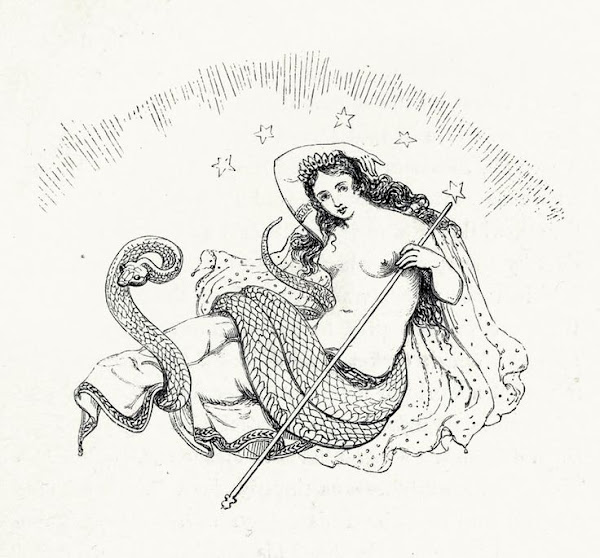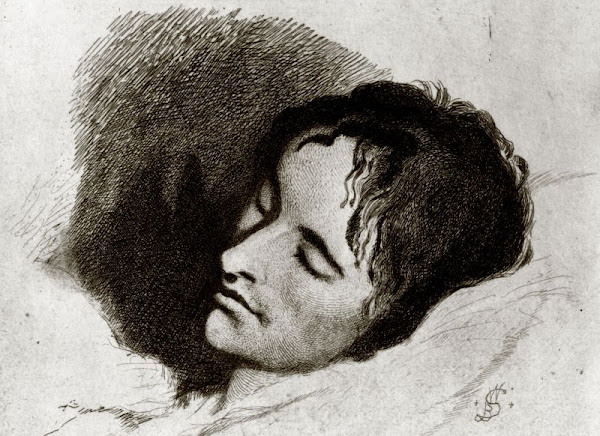 The Poetical Works of John Keats
The Poetical Works of John Keats•
 Vincent Gray: John Keats (2017)
Vincent Gray: John Keats (2017)John Keats: The Poetical Works (1866)
[Never Ending Books, Orewa - 23/11/2021]:
The Poetical Works of John Keats. With a Memoir by Lord Houghton [Richard Monckton Milnes]. Illustrated by 120 Designs, Original and from the Antique, Drawn on Wood by George Scharf, Jun. 1st ed. 1854. London: Edward Moxon and Co., 1866.
I found something interesting yesterday, in a little second-hand shop in Orewa, just up the coast from us. Bronwyn and I had gone for a drive to celebrate our fourteenth wedding anniversary (traditionally associated with ivory, but now - in our hopefully less ecologically tone-deaf times - gold).
Somehow - as usual - we ended up hunting through vintage shops, and in one of them I discovered an old copy of Keats with beautiful neo-classical designs by a certain George Scharf. I doubt that this is a particularly valuable book (though if one were to chance on the first edition of 1854 that might be a different story), but when I started to research it a bit, it turned out to be quite fascinating.
For a start, it includes a memoir by Richard Monckton Milnes [aka Lord Houghton], editor of the first substantive edition of Keats's collected works, The Life, Letters and Literary Remains of John Keats (2 vols, 1848). He benefitted greatly from the collections put together by Charles Armitage Brown, who passed them on to him before emigrating to New Zealand in 1841.
Brown died a year later. His grave can still be seen on Marsland Hill in New Plymouth, inscribed with his principal claim to fame: 'The friend of Keats.'
 Jane Campion, dir. & writ.: Bright Star (2009)
Jane Campion, dir. & writ.: Bright Star (2009)[l-to-r: Ben Whishaw as John Keats / Abbie Cornish as Fanny Brawne
Curiously enough, in Jane Campion's film Bright Star, which focuses principally on Keats's relationship with Fanny Brawne:
Brown (played by actor Paul Schneider) is presented as "the closest the movie comes to a villain, a cynical boor who knocks up his housemaid ... and banishes Fanny so the boys can work on their plays and poems."- Wikipedia: 'Charles Armitage Brown'
Film critic Ty Burr, who made this accusation in the first place, does, however, admit that Campion's 'portrayal of Brown's "love for Keats humanizes him... even if he loves the art more at first."'
The real value in my Orewa purchase, however, lies in the really quite beautiful set of illustrations it contains by the eventual President of the National Portrait Gallery, Sir George Scharf. At the time he'd just returned from two extensive journeys to Italy and Asia Minor, and was much in demand as an illustrator of books to do with classical art and antiquity.
Here's his version of the medieval imagery of Keats's 'Eve of St Agnes':
And here are some examples of the neo-classical style he is more generally associated with:
All in all, the precise, clean lines of Scharf's engravings make an agreeable contrast to the otherwise almost complete dependence Keats portraiture owes to the numerous paintings and sketches of his friend and travelling companion Joseph Severn.
Well-meant though these undoubtedly were, the cumulative effect of these images has been to portray the down-to-earth young surgeon John Keats as a more ineffectual, ethereal being than he apparently was in reality.
Scharf's illustrations provide a useful corrective to all that. In fact, until the appearance of Jane Campion's wonderful (and deeply influential) film in 2009, it's probably no exaggeration to describe him as one of the principal influences on Keatsian iconography.
Books I own are marked in bold:
-
Poetry:
- Keats, John. Poems. London: C. & J. Ollier, 1817.
- Endymion: A Poetic Romance. London: Taylor and Hessey, 1818.
- Endymion: A Poetic Romance. Type-facsimile of the First Edition with Introduction and Notes. 1818. Ed. H. Clement Notcutt. London: Humphrey Milford, Oxford University Press, 1927.
- Lamia, Isabella, the Eve of St. Agnes, and Other Poems. London: Taylor and Hessey, 1820.
- Lamia, Isabella, The Eve of St Agnes and Other Poems. Note on the Text by Michael Schmidt. Poetry First Editions. Harmondsworth: Penguin, 1999.
- The Poetical Works of John Keats. With a Memoir by Lord Houghton. Illustrated by 120 Designs, Original and from the Antique, Drawn on Wood by George Scharf, Jun. 1854. London: Edward Moxon and Co., 1866.
- The Poetical Works. Ed. H. Buxton Forman. 1908. Oxford Standard Authors. London: Geoffrey Cumberlege / Oxford University Press, 1953.
- The Poems. Ed. Miriam Allott. Longman Annotated English Poets. London: Longman, 1970.
- The Complete Poems. Ed. John Barnard. Penguin English Poets. 1973. Second Edition. 1977. Harmondsworth: Penguin, 1982.
- Stillinger, Jack, ed. The Poems of John Keats. The Definitive Edition. London: Heinemann Educational Books Ltd., 1978.
- Life, Letters, and Literary Remains of John Keats. 2 vols. Ed. Richard Monckton Milnes. 1848. Cambridge: Cambridge University Press, 2013.
- The Letters. Ed. Maurice Buxton Forman. 1931. Fourth Edition. London: Oxford University Press, 1952.
- Letters of Fanny Brawne to Fanny Keats [1820-1824]. Ed. Fred Edgcumbe. Foreword by Maurice Buxton Forman. 1937. London: Oxford University Press, 1939.
- The Keats Circle: Letters and Papers, 1816-1878 & More Letters and Poems of the Keats Circle, 1814-1879. 2 vols. Ed. Hyder Edward Rollins. Cambridge: Harvard University Press, 1948.
- Rollins, Hyder Edward, ed. The Keats Circle: Letters and Papers and More Letters and Poems of the Keats Circle: 1814-1879. 2 vols. 1948. 2nd ed. Preface by W. J. Bate. 1965. Cambridge: Harvard University Press, 1969.
- Vol. 1: 1816-1830
- Vol. 2: 1832-1878
- Rollins, Hyder Edward, ed. The Keats Circle: Letters and Papers and More Letters and Poems of the Keats Circle: 1814-1879. 2 vols. 1948. 2nd ed. Preface by W. J. Bate. 1965. Cambridge: Harvard University Press, 1969.
- The Letters of John Keats, 1814–1821. Ed. Hyder Edward Rollins. 2 vols. Cambridge: Harvard University Press, 1958.
- Selected Letters. Ed. Robert Pack. A Signet Classic. Ed. Harold Bloom. New York: New American Library, 1974.
- Gittings, Robert. John Keats: The Living Year, 21 September 1818 to 21 September 1819. 1954. London: Mercury Books, 1962.
- Gittings, Robert. John Keats. 1968. Pelican Biographies. Harmondsworth: Penguin, 1971.
- Motion, Andrew. Keats. 1997. London: Faber, 1998.
- Bright Star, writ. & dir. Jane Campion (based on Andrew Motion’s biography) – with Ben Whishaw, Abbie Cornish – (UK/Australia/France, 2009).
Letters:
Secondary:
•
- category - English Poetry (pre-1900): Nineteenth Century

































